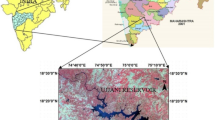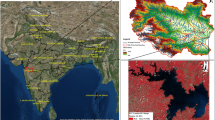Abstract
The present study aimed to evaluate the temporal dynamics of water stored in a reservoir using satellite remote sensing data integrated with a GIS application. The study is carried out in three reservoirs, which include Koga, Shina, and Selamko reservoirs located in the upper Blue Nile Basin. The techniques used to carry out this study have been pre and post-processing of Landsat images, modeling and identifying water pixels, evaluating reservoir capacity, and compression of results with recent bathymetric survey data. The Normalized Difference Water Index (NDWI) has been also employed to determine open water features and to improve the presence of water pixels in satellite imagery. Percentage Difference Area Index (PDAI) and Normal Difference Area Index (NDAI) techniques have been used to assess the deviation of storage area from satellite remote sensing, topo of bed elevation, and bathymetric survey. Results indicated that the Koga reservoir storage capacity has reduced from 83.10 to 81.179 Mm3, showing an annual storage loss of 0.33% (2009–2016). For Shina and Selamko reservoirs, annual storage loss due to sediment depositions is found to be 2.53% and 2.13% in a span of 9 and 11 years, exceeding the annual average worldwide rate for reservoir sedimentation of 1%. The findings of the study showed that the sedimentation problem was relatively severe as compared with the findings of most other studies of similar reservoirs in other parts of Ethiopia. The area needs some intensive soil and water management strategies for sustainable use of the reservoirs in the Blue Nile Basin. To regain the storage capacity of the reservoirs, it would be proposed to adopt manual and or mechanical dredging with flushing for de-silting the deposited sediments, especially in Shina and Selamko reservoirs.











Similar content being viewed by others
References
Annor FO, Van de Giesen N, Liebe J, Van de Zaag P, Tilmant A, Odai S (2009) Delineation of small reservoirs using radar imagery in a semi-arid environment: a case study in the upper east region of Ghana. Phys Chem Earth Parts A/B/C 34(4–5):309–315
Ashish P, Chaube U, Mishra S, Dheeraj K (2016) Assessment of reservoir sedimentation using remote sensing and recommendations for desilting Patratu Reservoir, India. Hydrol Sci J 61(4):711–718
Ayele GT, Kuriqi A, Jemberrie MA, Saia SM, Seka AM, Teshale EZ et al (2021) Sediment yield and reservoir sedimentation in highly dynamic watersheds: the case of Koga Reservoir, Ethiopia. Water 13(23):3374
Bhattacharya RK, Chatterjee ND, Das K (2020) Sub-basin prioritization for assessment of soil erosion susceptibility in Kangsabati, a plateau basin: a comparison between MCDM and SWAT models. Sci Total Environ 734:139474
Brown C (1943) Discussion of sedimentation in reservoirs. Proc Am Soc Civil Eng 69(6):1493–1499
Brune GM (1953) Trap efficiency of reservoirs. Eos Trans Am Geophys Union 34(3):407
Condé RdC, Martinez J-M, Pessotto MA, Villar R, Cochonneau G, Henry R et al (2019) Indirect assessment of sedimentation in hydropower dams using MODIS remote sensing images. Remote Sens 11(3):314
Dadoria D, Tiwari H, Jaiswal R (2017) Assessment of reservoir sedimentation in Chhattisgarh state using remote sensing and GIS. Int J Civ Eng Technol 8(4):526–534
Eguavoen I, Tesfai W (2012) Social impact and impoverishment risks of the Koga irrigation scheme, Blue Nile basin, Ethiopia. Afrika Focus 25(1):39–60
Elsahabi M, Negm A, Ali K (2018) Assessment of sedimentation capacity in Lake Nasser, Egypt, utilizing RS and GIS. Procedia Manuf 22:558–566
Foteh R, Garg V, Nikam BR, Khadatare MY, Aggarwal SP, Kumar AS (2018) Reservoir sedimentation assessment through remote sensing and hydrological modeling. J Indian Soc Remote Sens 46(11):1893–1905
Haregeweyn N, Melesse B, Tsunekawa A, Tsubo M, Meshesha D, Balana BB (2012a) Reservoir sedimentation and its mitigating strategies: a case study of Angereb reservoir (NW Ethiopia). J Soils Sediments 12(2):291–305
Haregeweyn N, Berhe A, Tsunekawa A, Tsubo M, Meshesha DT (2012b) Integrated watershed management as an effective approach to curb land degradation: a case study of the Enabered watershed in northern Ethiopia. Environ Manag 50(6):1219–1233
Howard CDD (2000) Operations, monitoring and decommissioning of dams. Thematic Review IV 5. Input to the World Commission on Dams, Cape Town, https://www.dams.org/
Hui F, Xu B, Huang H, Yu Q, Gong P (2008) Modelling spatial-temporal change of Poyang Lake using multitemporal Landsat imagery. Int J Remote Sens 29(20):5767–5784
Ikhar P, Regulwar D, Kamodkar R (2018) Optimal reservoir operation using soil and water assessment tool and genetic algorithm. ISH J Hydraul Eng 24(2):249–257
Issa IE, Al-Ansari N, Knutsson S, Sherwany G (2015) Monitoring and evaluating the sedimentation process in Mosul Dam Reservoir using trap efficiency approaches. Engineering 7(4):190–202
Jain SK, Goel M (2002) Assessing the vulnerability to soil erosion of the Ukai Dam catchments using remote sensing and GIS. Hydrol Sci J 47(1):31–40
Jain SK, Singh P, Seth S (2002) Assessment of sedimentation in Bhakra Reservoir in the western Himalayan region using remotely sensed data. Hydrol Sci J 47(2):203–212
Jaiswal RK, Thomas T, Galkate R, Jain S (2009) Assessment of sedimentation in ravishankar Sagar reservoir using digital image processing techniques. J Environ Res Develop 3(4):1238–1245
Kondolf GM, Gao Y, Annandale GW, Morris GL, Jiang E, Zhang J et al (2014) Sustainable sediment management in reservoirs and regulated rivers: experiences from five continents. Earth’s Future 2(5):256–280
Lane EW (1943) The density of sediments deposited in reservoirs. St Paul US Engineer District Sub-Office, Hydraulic Laboratory, University of Iowa
Liebe J, Van De Giesen N, Andreini M (2005) Estimation of small reservoir storage capacities in a semi-arid environment: a case study in the Upper East Region of Ghana. Phys Chem Earth Parts A/B/C 30(6–7):448–454
Manavalan P, Sathyanath P, Sathyanarayn M, Raje Gowda G (1990) Capacity evaluation of the Malaprabha reservoir using digital analysis of satellite data. Tech Report no RC: BO: WR, vol 1. Regional Remote Sensing Service Centre, Bangalore, and Karnataka Engineering Research Station, Krishnarajsagar, India, p 90
Merina R, Sashikkumar M, Rizvana N, Adlin R (2016) Sedimentation study in a reservoir using remote sensing technique. Appl Ecol Environ Res 14(4):296–304
Mhiret DA, Ayana EK, Legesse ES, Moges MM, Tilahun SA, Moges MA (2016) Estimating reservoir sedimentation using bathymetric differencing and hydrologic modeling in data-scarce Koga watershed, Upper Blue Nile. J Agric Environ Int Dev (JAEID) 110(2):413
Mishra S (2017) Management of the sediment transported by the south Mahanadi deltaic rivers to the Chilika lagoon. Int J Adv Res 5(6):1005–1020
Mishra SP, Kumar C, Mishra A, Mishra S, Patel A (2021) Estimation of sediments in Rengali Reservoir, Odisha (India) using remote sensing. Int J Environ Clim Change. https://doi.org/10.9734/ijecc%2F2021%2Fv11i1230572
Moges MM, Abay D, Engidayehu H (2018) Investigating reservoir sedimentation and its implications to watershed sediment yield: the case of two small dams in data-scarce upper Blue Nile Basin, Ethiopia. Lakes Reserv Res Manag 23(3):217–229
Mukherjee S, Veer V, Tyagi SK, Sharma V (2007) Sedimentation study of Hirakud Reservoir through remote sensing techniques. J Spat Hydrol 7(1):122–130
Mulengera P-MB, Manzungu F, Kileshye-Onema J (2012) ICT-based identification and characterisation of small reservoirs in the Limpopo River Basin in Zimbabwe. Environ Nat Resour Res 2(3):25–42. https://doi.org/10.5539/enrr.v2n3p25
Nayana PL, Vilas JB (2015) Evaluation of the loss of capacities due to sedimentation in reservoirs by hybrid method. Int J Adv Eng Technol 7(6):1691
Ouyang W, Hao F, Skidmore AK, Toxopeus A (2010) Soil erosion and sediment yield and their relationships with vegetation cover in the upper stream of the Yellow River. Sci Total Environ 409(2):396–403
Pandey A, Chaube U, Mishra S, Kumar D (2016) Assessment of reservoir sedimentation using remote sensing and recommendations for desilting Patratu Reservoir. India Hydrol Sci J 61(4):711–718
Peng D, Guo S, Liu P, Liu T (2006) Reservoir storage curve estimation based on remote sensing data. J Hydrol Eng 11(2):165–172
Prasad NR, Garg V, Thakur PK (2018) Role of SAR data in water body mapping and reservoir sedimentation assessment. ISPRS Ann. Photogramm. Remote Sens. Spatial. Inf. Sci. IV-5:151–158. https://doi.org/10.5194/isprs-annals-IV-5-151-2018
Qian B, Zhang D, Wang J, Huang F, Wu Y (2016) Impacts of reservoirs on the streamflow and sediment load of the Hanjiang River, China. Environ Monit Assess 188(11):1–10
Rashid MU, Shakir AS, Khan NM, Latif A, Qureshi MM (2015) Optimization of multiple reservoir operations with consideration to sediment evacuation. Water Resour Manag 29(7):2429–2450
Reynolds B (2012) Variability and change in Koga reservoir volume, Blue Nile, Ethiopia: Variabilitet och förändring i Kogadammens vattenvolym, Blå Nilen, Etiopien
Rodrigues L, Senzanje A, Cecchi P, Liebe J (2010) Estimation of small reservoir storage capacities in the São Francisco, Limpopo, Bandama and Volta river basins using remotely sensed surface areas. EGU General Assembly 2010, Held 2–7 May, 2010 in Vienna, Austria. vol 12, p 6645
Rodrigues LN, Sano EE, Steenhuis TS, Passo DP (2012) Estimation of small reservoir storage capacities with remote sensing in the Brazilian Savannah Region. Water Resour Manag 26(4):873–882
Sawunyama TENDAI, Senzanje A, Mhizha A (2006) Estimation of small reservoir storage capacities in Limpopo River Basin using geographical information systems (GIS) and remotely sensed surface areas: Case of Mzingwane catchment. Physics and Chemistry of the Earth, Parts A/B/C 31(15–16):935–943
Schleiss AJ, Franca MJ, Juez C, De Cesare G (2016) Reservoir sedimentation. J Hydraul Res 54(6):595–614
Shendge R, Chockalingam M (2016) Review of reservoir sedimentation. Remote Sens GIS Technol Int J Innov Eng Res Technol (IJIERT) 3(6):45–51
Singh KV, Setia R, Sahoo S, Prasad A, Pateriya B (2015) Evaluation of NDWI and MNDWI for assessment of waterlogging by integrating digital elevation model and groundwater level. Geocarto Int 30(6):650–661
Verstraeten G, Poesen J (2000) Estimating trap efficiency of small reservoirs and ponds: methods and implications for the assessment of sediment yield. Prog Phys Geogr 24(2):219–251
Vishwakarma Y, Tiwari H, Jaiswal R (2015) Assessment of reservoir sedimentation using remote sensing technique with GIS model-a review. Int J Eng Manag Res 5(3):411–417
Wagh S, Manekar V (2021) Assessment of reservoir sedimentation using satellite remote sensing technique (SRS). J Inst Eng India Ser A 102(3):851–60
Xu H (2006) Modification of normalized difference water index (NDWI) to enhance open water features in remotely sensed imagery. Int J Remote Sens 27(14):3025–3033
Acknowledgements
This study was partially supported by the University of Gondar, where the support was funding for transportation in observed data collection. The authors would like to express their sincere thanks to the Abay basin authority office, and the Ethiopian Road Authority for providing the necessary data and research facilities. Our special thanks go to the farmers in the Koga, Shina, and Selamko who helped us greatly in putting the control points at the shoreline of the reservoirs on the imaging data.
Funding
This research received not much external funding.
Author information
Authors and Affiliations
Contributions
All authors conceived and designed the research. Conceptualization: ATT, MAM and MMM; investigation: ATT, and MAM; writing—original draft preparation: ATT; writing—review and editing: MAM, MMM, AWW, DTD, and ABW All authors have read and agreed to the published version of the manuscript.
Corresponding author
Ethics declarations
Conflict of interest
The authors declare that they have no known competition for financial and conflict of interests that could have appeared to influence the work reported in this paper.
Data availability statement
The datasets generated during and/or analyzed during the current study are available from the corresponding author upon reasonable request.
Additional information
Publisher's Note
Springer Nature remains neutral with regard to jurisdictional claims in published maps and institutional affiliations.
Rights and permissions
Springer Nature or its licensor (e.g. a society or other partner) holds exclusive rights to this article under a publishing agreement with the author(s) or other rightsholder(s); author self-archiving of the accepted manuscript version of this article is solely governed by the terms of such publishing agreement and applicable law.
About this article
Cite this article
Tesfaye, A.T., Moges, M.A., Moges, M.M. et al. Reservoir sedimentation evaluation using remote sensing and GIS approaches for the reservoirs in the upper Blue Nile Basin. Sustain. Water Resour. Manag. 9, 23 (2023). https://doi.org/10.1007/s40899-022-00792-0
Received:
Accepted:
Published:
DOI: https://doi.org/10.1007/s40899-022-00792-0




